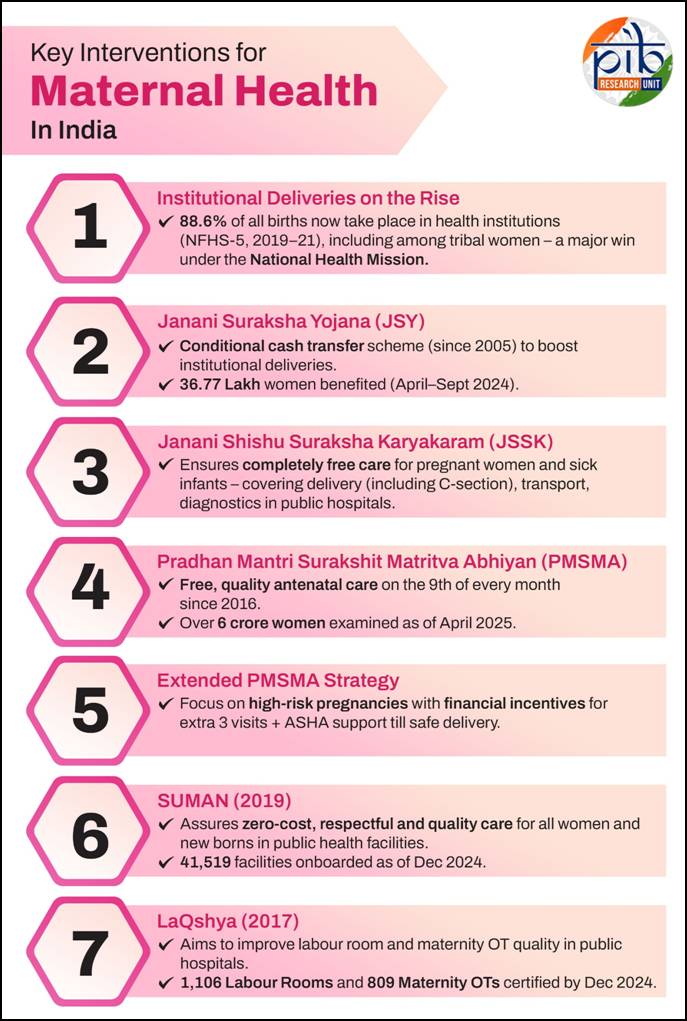World Health Day 2025

- 08 Apr 2025
In News:
World Health Day, observed annually on 7 April, highlights pressing global health issues and mobilises action to improve public health outcomes.
- Established by: World Health Organization (WHO)
- First celebrated: 1950
Overview and Significance
World Health Day is commemorated to mark the founding of the WHO in 1948. It serves to raise awareness about global health issues and mobilize efforts to improve public health outcomes.
The 2025 theme, Healthy Beginnings, Hopeful Futures, emphasizes maternal and newborn health, calling for coordinated efforts to eliminate preventable deaths and support long-term well-being of women and children.
This year’s observance launches a year-long global campaign aimed at:
- Promoting safe pregnancies and institutional deliveries
- Supporting maternal nutrition and postnatal care
- Encouraging healthcare equity for women and newborns
India’s Progress in Maternal and Child Health
India has made significant strides through initiatives under the Ministry of Health and Family Welfare, particularly via Ayushman Bharat and the National Health Mission (NHM).
Key Health Indicators (India vs Global, 1990–2020)
Indicator India Reduction (%) Global Reduction (%)
Maternal Mortality Ratio 83% 42%
Neonatal Mortality Rate 65% 51%
Infant Mortality Rate 69% 55%
Under-5 Mortality Rate 75% 58%
Recent National Data:
- MMR reduced from 130 (2014–16) to 97 (2018–20) per 1,00,000 live births
- IMR dropped from 39 (2014) to 28 (2020)
- NMR reduced from 26 (2014) to 20 (2020)
- U5MR declined from 45 (2014) to 32 (2020)
Major Initiatives for Maternal and Child Health
- Maternal Death Surveillance and Response (MDSR): Tracks maternal deaths and implements corrective measures.
- Mother and Child Protection (MCP) Card: Educates women on nutrition, rest, and health entitlements.
- Reproductive and Child Health (RCH) Portal: Tracks maternal and child health services.
- Anaemia Mukt Bharat: Focuses on anaemia reduction under POSHAN Abhiyan.
- Birth Waiting Homes: Ensures institutional deliveries in remote areas.
- VHSNDs and Outreach Camps: Deliver maternal and child services in rural and tribal areas.
Healthcare Access and Infrastructure
- Ayushman Arogya Mandirs (HWCs): 1.76 lakh active centers
- 107.10 crore screenings for hypertension
- 94.56 crore screenings for diabetes
- 5.06 crore wellness sessions (e.g., yoga) conducted
- 17,000+ health facilities certified under National Quality Assurance Standards (NQAS)
Digital Health Ecosystem
- Ayushman Bharat Digital Mission (ABDM):
- 76+ crore ABHA IDs
- 5.95 lakh verified healthcare professionals
- 52+ crore linked health records
- U-WIN Platform:
- 7.90 crore beneficiaries
- 1.32 crore vaccination sessions
- 29.22 crore vaccine doses administered
- eSanjeevani Telemedicine:
- Over 36 crore consultations
- World's largest primary telehealth platform
- 130+ specialities, 131,793 spokes, and 17,051 hubs
Disease Elimination Success
- The WHO World Malaria Report 2024 highlights India’s major strides in malaria elimination, with a 69% drop in cases and 68% reduction in deaths between 2017 and 2023.
- Contributing just 0.8% of global cases in 2023, India’s exit from WHO's High Burden to High Impact (HBHI) group in 2024 marks a significant public health achievement.
- The Government of India has eliminated Trachoma as a public health problem in 2024, a feat recognised by the WHO.
- The Government of India’s proactive Measles-Rubella vaccination drive, strong surveillance, and public awareness efforts have greatly improved public health.
- According to WHO’s Global TB Report, India has made strong progress in tuberculosis control.
- Under the National Tuberculosis Elimination Programme (NTEP), TB incidence fell by 17.7%, from 237 to 195 cases per lakh population between 2015 and 2023.
- TB-related deaths also declined from 28 to 22 per lakh.
- Notably, missing TB cases dropped by 83%, from 15 lakh in 2015 to 2.5 lakh in 2023.
- As of 6th April, 2025, the Pradhan Mantri TB Mukt Bharat Abhiyaan, launched in September 2022, has registered over 2.5 lakh Ni-kshay Mitra volunteers supporting over 15 lakh TB patients. This initiative has further been expanded to include family members of TB patients.
- Kala-azar Elimination: India has successfully achieved Kala-azar elimination as of October 2024, with 100% of endemic blocks reaching the target of less than one case per 10,000 population by the end of 2023.
